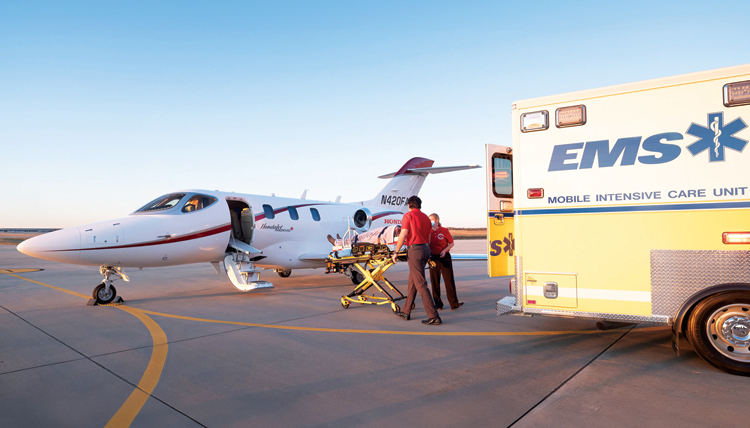Business Aviation — A Force for Good
Business aviation is part of General aviation and plays a vital role in fostering economic development, supporting communities, advancing technology, and facilitating humanitarian efforts
 | By SUDHIR RAJESHIRKE |

Amongst the general public, business aviation is often regarded as a luxury or niche sector of aviation and hence doesn’t receive the responsiveness and assistance from the Government and State entities that that it truly deserves. The reason is that not many are aware that business aviation is part of general aviation that encompasses a wide range of activities from private flying to aerial surveys, emergency medical services, general aviation terminals often known as Fixed Base Operators (FBOs) and police surveillance etc.
General aviation thus serves as a crucial force for good in numerous aspects of modern society. Often overshadowed by commercial and military aviation, general aviation plays a vital role in fostering economic development, supporting communities, advancing technology, and facilitating humanitarian efforts.
Hence as the Ministry of Civil Aviation (MoCA) with new leadership is in the process of developing new initiatives to further the aviation sector, it would be worthwhile to recognise that the general aviation is a force for good and hence here are four initiatives that the Ministry can focus on to provide immediate revival for the general aviation industry.
- Aircraft Fractional Ownership Framework: At its core, business aviation enhances efficiency and productivity in ways that commercial aviation cannot always match. By providing companies and individuals, entrepreneurs and business leaders with direct, flexible, and rapid transportation options, it enables executives, experts, and decision-makers to reach their destinations swiftly and on their own schedules. This agility translates into faster decision-making processes, increased face-to-face interactions crucial for business deals and relationships, and the ability to respond swiftly to emergencies and opportunities alike. This makes a business jet or a helicopter as essential tool for business aviation.
However, there are two key challenges in owning and operating business aircraft. First, the differential taxation between commercial and private categories of aircraft encourages companies to consider importing and operating aircraft under commercial category. However, there is another hurdle. To operate just one aircraft, companies have to establish an aviation company, that is not their core business. Further, considering the amount of flying i.e. under 200 hours per year, it does not make commercial sense for a lot of companies to invest in purchasing a full aircraft. All these factors discourage companies in using business aviation altogether. Hence the industry growth has been flat for the last two decades.
THE MINISTRY OF CIVIL AVIATION (MOCA) WITH NEW LEADERSHIP IS IN THE PROCESS OF DEVELOPING NEW INITIATIVES TO FURTHER THE AVIATION SECTOR, RECOGNISING THAT GENERAL AVIATION IS A FORCE FOR GOOD.
Aircraft fractional ownership model solves all the challenges above. First, the companies have to invest only a fraction of the cost of aircraft. This reduces their CAPEX investment and hence more companies would find it affordable to acquire an aircraft. Secondly, the responsibility of operation is assigned to a professional aviation company. This removes second hurdle of operating and managing a complicated aviation asset. Finally, the overall cost of flying is reduced and service standards are improved.
Due to several customer favorable factors, aircraft fractional ownership programmes is likely to significantly improve the fleet strength of both business jets and helicopters in India. These aircraft will likely be deployed for religious flying, NGO efforts and other humanitarian purposes.
Since last two years, Business Aircraft Operator Association (BAOA) has been working with MoCA to create ta framework under which the fractional model can be implemented. The framework is ready and hence MoCA can release the framework and thus roll out implementation of the well-known and well accepted business model that will increase business aircraft ownership in India.
- Emergency Medical Services (EMS): For a population of 1.4 billion people, there are fewer than ten helicopters and business aircraft that are currently used for emergency medical services. This is an abysmal figure for a vast country such as India. According to official statistics published by the Ministry of Road Transport and Highways (MoRTH), 1,53,972 persons were killed in road crashes in the year 2021. The medical infrastructure in tier 2 and tier 3 cities is limited. Hence for patients to access high quality medical services in case of emergencies becomes a challenge. Further, during natural disasters, especially in the mountainous regions, there is very limited capacity to the relief agencies to rescue people in distress. Organisations like NGOs, relief agencies, and medical teams rely on business aviation to access regions where infrastructure may be limited or compromised, demonstrating its crucial role in humanitarian logistics.
This is the second area where MoCA can spur the next level of growth for emergency medical services. However, what currently prevents the availability of general aviation aircraft for emergencies is the lack of scalable business model that would encourage private companies to provide EMS. Hence there is a need for the States to invest in such EMS programmes through public private participation. MoCA has initiated a Sanjeevani programme in which a pilot HEMS project will soon be launched at AIIMS Rishikesh. However, more needs to be done and soon. MoCA needs to encourage States to launch their own EMS programmes using a broad framework used in MoCA pilot project.

EMS programmes can be launched in two models by the States. In first model, States can lease a helicopter or a business aircraft that is fully EMS equipped from an existing operator. Fixed guaranteed hours per month can be provided so that the operator can cover the fixed costs per month and make a reasonable profit from the asset. The operator can either purchase an aircraft or use an existing one from the fleet and configure it to provide EMS. This model helps any State to launch an EMS programme quickly along with an experienced operator. The second model is one which the State can itself launch the programme using its own aviation department. A State can purchase or lease an aircraft, configure it for EMS operations and launch its own services for the State. The aircraft can also be loaned to other States for relief efforts. The States have the financial capacity and people to launch EMS quickly without the need to think of financial returns.
Thus, the EMS using business aircraft or HEMS using helicopters can spur massive humanitarian efforts in the country.
- Police Surveillance: Police surveillance using helicopters is a not known concept in India, but one that needs attention as it provides significant benefits to society by enhancing law enforcement capabilities, improving public safety, and aiding in emergency response situations. Helicopters are useful in several ways for police surveillance such as enhanced situational awareness on ground for monitoring large areas quickly and effectively, crime prevention and detection, emergency response and disaster relief activities, and public event and crowd control.
In summary, police surveillance using helicopters is a critical tool that enables law enforcement agencies to enhance public safety, respond effectively to emergencies, and support various aspects of community policing. By leveraging aerial capabilities, police can better protect communities, prevent crimes, and provide swift assistance during crises, ultimately contributing to a safer and more secure society.
The strategy to implement at State level is for MoCA to engage with State police agencies and follow the two models that are recommended for HEMS operations above.
- General Aviation Terminals and Dedicated Space for GA Aircraft at Airports: This is a large untapped market that needs highest priority. Mumbai is an excellent example in which there is high concentration of wealth and has a high demand from business aircraft, but has very minimal parking space and support function areas. Hence the demand for general aviation flights has stagnated.
India requires a worldclass level infrastructure of General Aviation Terminals (GAT) or Fixed Based Operators (FBO) which number less than five in India. GATs or FBOs offer a range of services that include fueling, maintenance, ground handling, parking and other facilities that are essential for operation of general aviation aircraft. Hence when Airport Authority of India (AAI) plans new airports or considers expansion of existing ones, parking space should be allocated for business aircraft for current and future aircraft inductions. A dedicated space should also be allotted to small or large FBO depending on historical and potential business aviation traffic. Promoting business aviation should now figure in the civil aviation policy making process as well.
Promotions by Local State Governments. State Governments have their own internal need for private aircraft (fixed wing or helicopter) travel and many have a dedicated civil aviation department. The civil aviation department can build small FBOs at airports where there is significant State and private aircraft travel. A saying goes “Build and they will come”. Once State officials, business persons experience the ease of rapid checking through an FBO, they will prefer it over commercial terminal any day.
In conclusion, business aviation transcends its luxury image to become a vital force for good in today’s interconnected world. From enhancing business efficiency and supporting humanitarian efforts to driving economic growth and technological innovation, its impact is diverse and profound. As the sector continues to evolve, embracing sustainability and innovation, its positive contributions to global connectivity and prosperity are set to grow, making it an indispensable element of modern aviation and economic development.
Sudhir Rajeshirke is an experienced executive in the business and general aviation industry and is passionate about growing the aviation industry in India.





